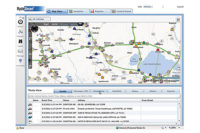Telematics advance the game
Technology gives beverage distribution companies an edge

To stay competitive in the beverage world, multiple factors need to be considered. Is your product filling a need? Is it well received? Are you producing it in the most cost-efficient way possible? How’s the delivery? Is your distribution system working as well as it could be? While these are just a few of the facets that need to be taken into consideration, one aspect of beverage distribution is becoming ever more important to on-time delivery and management: telematics.
Helping companies verify current locations as well as historical locations, vehicle routes of a single truck or entire fleet plays a huge roll in streamlining dispatching, routing and can improve customer service, experts say. According to Craig Whitney, vice president of marketing for San Diego, Calif.-based Networkfleet Inc., it is estimated that less than 20 percent of all fleet vehicles are currently using telematics. But, he notes, “this number is increasing rapidly.”
The potential use, notes Lisa Chiranky, director of marketing for Teletrac Inc., Garden Grove, Calif., is unlimited, and will continue to rise with more stringent regulations being issued, and efficient operations becoming a must-have for beverage companies.
And as more and more companies employ GPS telematics in distribution, more and more of the services assets are revealed.
“Telematics solutions help managers improve safety with real-time reporting of safety and fleet analytics,” notes Chiranky. “And when the GPS is integrated with the vehicle’s electric on-board recorder (EOBR), the entry, recording, completion and storage of drivers’ e-log books can be automated right from the cab.” This, Chiranky says, can alert drivers and supervisors to pending hours of service violations.
Beverage companies that use Teletrac’s Fleet Director application can chalk up tighter security, enhanced safety and improving overall service while cutting costs to the list of the application’s benefits, the company says.
“Customer expectations run high and the Teletrac fleet tracking system helps exceed them,” Chiranky notes. “By knowing each vehicle’s exact location and availability, dispatch can provide an immediate answer to a midday call-in customer who wants to know if they’ll get their shipment that afternoon.”
An everyday practice
Telematics have seen a rush of usage during the past few years as beverage distribution becomes more sophisticated. Additionally, skyrocketing price of fuel these days has deemed GPS telematics essential.
“The rising price of fuel has made wireless fleet management systems even more critical to all types of fleets,” Networkfleet’s Whitney says.
The company currently offers two fleet solutions, the Networkfleet 3500 and the Networkfleet 4200, both of which offer full-featured and easy-to-use web-based applications in addition to reporting and alerts.
“Fleet managers who have implemented wireless fleet management systems report a quick ROI, due primarily to the significant savings in fuel and other operating costs,” Whitney says.
Networkfleet’s telematics fuel-saving features, for example, can alert and report idling and speed violations, unauthorized fuel purchases, fuel usage reports for detailed purchase, miles per gallon monitoring and more. The features not only make up for fuel costs, but also can reduce overall operating costs by 10 to 20 percent, Whitney says.
Besides the cost of fuel, Teletrac Inc.’s Chiranky notes that tighter compliance requirements and a rising cost of doing business also have affected the increase in telematics’ use.
“New technologies can address these changing conditions,” she explains, citing significant gains in efficiencies, improved on-time performance and helping drivers and dispatchers to be more productive.
The future is now
It’s inevitable that telematics will continue to grow into an even bigger player in beverage distribution. Technology is constantly improving and it’s in a company’s best interest — and bottom line — to keep up.
As more fleets ask for telematics, Chiranky says, they “will grow as the biggest onboard technology.” She notes that managers looking for relief in their operating expenses from preventative maintenance, and federal regulations like the Comprehensive Safety Analysis 2010 guidelines are encouraging more companies to implement GPS integrated with EOBR to meet compliance deadlines.
The trend also is catching the attention of truck manufacturers, such as Hino Trucks, Novi, Mich. The manufacturer developed Hino Insight solution, a web-based location and telematics solution for the medium-duty commercial truck market. Hino Insight provides innovative GPS-based, remote fleet management capabilities to fleet operations, including driving efficiencies, safety, security, customer satisfaction and green initiatives. The solution is offered for Hino’s 2008 through 2012 model year trucks with customized solutions available.
The company partnered with Canadian company WebTech Wireless to develop Insight, which took two years and more than 1 million miles of testing, the company says. The solution contains a mix of premium and Hino-exclusive services that range from route tracking, geofencing, advanced vehicle administration and planned maintenance management to Hino’s proprietary diagnostic alerts, custom fleet performance dashboard reporting and remote door unlock telemetry.
Hino Insight maintains an online dashboard that is designed for fleet managers to gain a daily snapshot of their fleets’ critical diagnostic status and performance against established targets, the company says. Through the web-based Insight Dashboard fleet managers can simultaneously access real-time vehicle and driver-related information, including features such as an idle time fuel savings opportunity calculator, identifications of trucks with the greatest performance improvement opportunities, Diesel Exhaust Fluid tank level monitoring. The Dashboard also feature’s Hino’s proprietary diagnostics critical alerts, which is a characteristic of telematics solutions that is catching on.
Networkfleet’s Whitney points out that telematics “continually evolve toward prognostics” that help to anticipate and fix critical vehicle or equipment issues, and which can help prevent unnecessary maintenance costs or failures.
“These systems will gather more and more data from engines through sensors and then combine that data with predictive statistics to help identify and diagnose potential sources of problems,” Whitney says.
The fact is that beverage companies these days are paying strict attention to their own distribution facts, and telematics can help keep them in check across the board.
“For a service fleet,” Chiranky says, “adding one more stop per day per vehicle can add up to hundreds of thousands of additional dollars to the bottom line.” BI
Looking for a reprint of this article?
From high-res PDFs to custom plaques, order your copy today!





